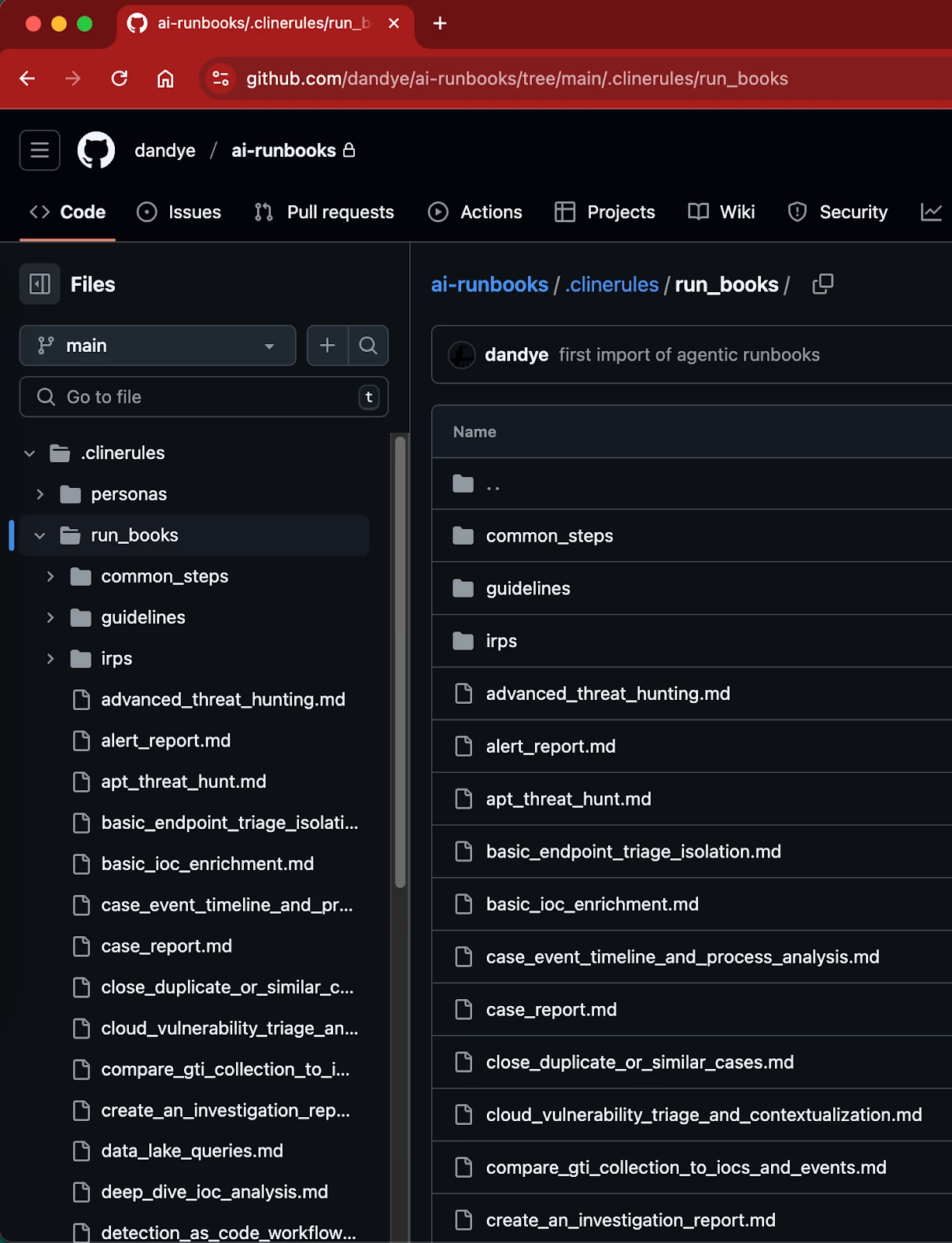Google recently introduced Model Context Protocol (MCP) Servers for Google Security Operations (SecOps), Google Threat Intelligence (GTI), and Google Security Command Center (SCC). They are run locally and you can interact with them from clients like Google’s Agent Development Kit (ADK) or Anthropic’s Claude. My own preference is to run them from an Integrated Development Environment (IDE) like Cursor, Windsurf, Roo, or what I will demo here: Cline.
I prefer the IDE for several reasons. I have the MCP servers and Large Language Model (LLM) generate markdown documents for each research and analysis interaction. The IDE makes it easy to get a rich preview of those markdown documents and also to commit them to my source control (git). Secondly, my first prompts were typed into the Cline message box, but I quickly realized that I needed them in a text editor as I needed to iterate on them. That quickly evolved into something of an existing best practice for security operations centers: runbooks.
So today, I’m introducing a collection of these runbooks and their supporting files. These are not meant for production use, but rather to showcase the potential of AI runbooks. The runbooks are all currently stored in the .clinerules directory of the GitHub project, so that they are in the context window for every interaction.
 https://github.com/dandye/ai-runbooks
https://github.com/dandye/ai-runbooks
Bridging the Gap: MCP Servers for Security Tools
Before diving into that .clinerules directory, let's talk about the new MCP servers used by this project. MCP allows LLMs to interact directly with external tools and data sources in a standardized way. Google’s new security-focused MCP servers are:
- secops-mcp: Provides tools for interacting directly with Google SecOps SIEM (e.g., searching events, looking up entities, getting alerts).
- secops-soar: Enables interaction with Google SecOps SOAR for case management, playbook actions, and orchestration. Extensible via marketplace integrations.
- gti-mcp: Offers access to the rich dataset of Google Threat Intelligence for IOC enrichment, threat actor research, and vulnerability context.
- scc-mcp: Allows querying Google Security Command Center for cloud security posture findings.
These servers give our LLM the ability to perform real security actions and gather critical data directly from the platforms analysts use daily.
Introducing AI Runbooks: Guiding the AI
While MCP servers provide the ability to act, the .clinerules directory provides the guidance on how and when to act. Located at the root of the project, this directory serves as a knowledge base, codifying operational context, standard procedures, and role-specific perspectives for the LLM.
The goal is to make the LLM more effective, consistent, and aligned with our specific security environment and practices.
Personas and Runbooks
The primary types of guidance are:
- Personas (./personas/)
- What: These files define standard roles within a security team – SOC Analyst (Tiers 1-3), Incident Responder, Threat Hunter, CTI Researcher, Security Engineer, Compliance Manager, SOC Manager, and even CISO.
- Why: Each persona description outlines typical responsibilities, skills, commonly used MCP tools, and relevant runbooks.
- Impact: This helps the LLM understand the user's likely perspective and intent based on their role. It allows the LLM to tailor its responses, select the most appropriate tools from the MCP servers, and suggest relevant workflows (runbooks) for the task at hand. It also helps a great deal in *writing* the runbooks.
- Runbooks (./run_books/)
- What: These are documented, step-by-step procedures for specific security operations tasks. Think of them as executable plans for the LLM. Examples include triaging alerts, enriching IOCs, hunting for specific TTPs, or responding to phishing emails.
- Why: Runbooks ensure consistency and adherence to established procedures. They guide the LLM in selecting and sequencing the right MCP tools to accomplish a task effectively. Many include Mermaid diagrams to visualize the workflow.
- IRPs vs. Runbooks: We distinguish between:
- Incident Response Plans (IRPs): Located in ./run_books/irps/, these are end-to-end strategies for major incident types (Malware, Phishing, Ransomware, Compromised User) following the PICERL model. They orchestrate multiple steps and often call other, more specific runbooks.
- Runbooks: Found in ./run_books/ or ./run_books/common_steps/, these provide tactical steps for specific tasks (e.g., enrich_ioc.md, triage_alerts.md) or reusable procedures often used within IRPs.
- Impact: Runbooks provide the LLM with a clear plan, leveraging the specific capabilities of the MCP servers in a structured way. This leads to more predictable and reliable execution of security workflows.
The Synergy: Run Books + MCP Servers
To recap:
- Personas help the LLM understand who is asking and what they likely need.
- Runbooks tell the LLM how to achieve a specific goal using the available tools.
- MCP Servers provide the actual tools (like gti-mcp.get_file_report or secops-mcp.search_security_events) that the LLM uses, guided by the runbooks and personas.
This synergy enables the LLM to operate more like an experienced analyst, following best practices and leveraging specialized tools effectively within our specific operational context.
What’s Next?
I’ve added a lot of planning documents to the project. For example, the .clinerules/readme.md also outlines suggestions for future context files, including network maps, asset inventory guidelines, tool configurations, organizational policies, and internal threat profiles. Adding these will further enhance the LLM’s environmental awareness and decision-making capabilities. I want to note that much of this planning, like the other content, came directly from Gemini 2.5 itself, by iteratively executing the runbooks and then asking the LLM, “how could we improve this process?”
Below is a brief video of that kind of interaction.
Execute and Improve APT Hunt Runbook YouTube video.
Conclusion
The use of runbooks with the new security-focused MCP servers represents a significant step forward in making LLM powerful allies in the SOC. By providing structured guidance, operational context, and direct access to security platforms, we can improve the consistency, speed, and effectiveness of our security operations. Check out the introduction video below and explore the .clinerules directory in the GitHub repo to see these concepts in action!
